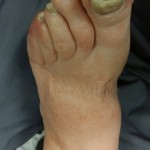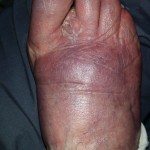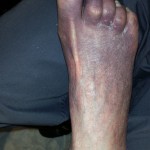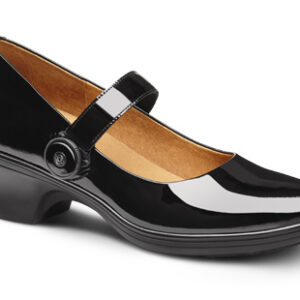Foot Circulation
Foot Circulation is vital to the overall health of the feet. When foot circulation is not adequate various circulation related issues can develop. Peripheral vascular disease (PVD) is a form of cardiovascular disease primarily affecting the blood vessels of the extremities. Cigarette smoking, high cholesterol, diabetes mellitus are major risk factors
- Pitting edema of the foot with perfect shoe imprint
- Vascular wound
- Discoloration and edema in vascular compromised
- Blue purple discolration associated with decreased circulation
The anatomy of the vessels responsible for supplying and returning the blood from the feet is critical to understanding foot circulation. Debates over the the number of palpable pulses in the feet varies with circulation, we commonly assess 2 with our patients, the posterior tibial pulse and the dorsalis pedis.
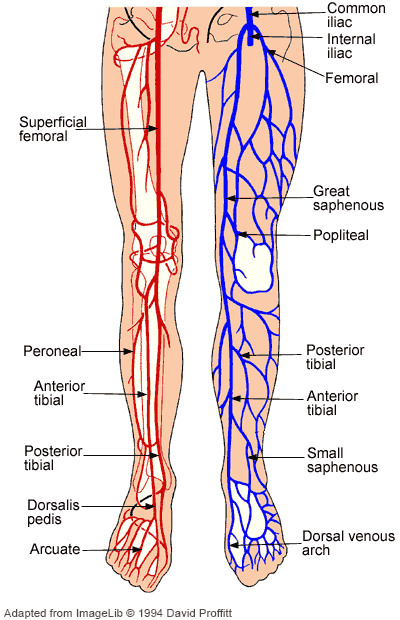
Description of Circulation Problems
Vascular disease is a pathological state of large, medium, and small arteries and is triggered by endothelial cell dysfunction. Because of factors like pathogens, oxidized LDL particles and other inflammatory stimuli endothelial cells become activated. This leads to changes in their characteristics: endothelial cells start to excrete cytokines and chemokines and express adhesion molecules on their surface. This results in recruitment of white blood cells (monocytes and lymphocytes), which can infiltrate the blood vessel wall. Stimulation of smooth muscle cell layer with cytokines produced by endothelial cells and recruited white blood cells causes smooth muscle cells to proliferate and migrate towards the blood vessel lumen. The process causes thickening of the vessel wall, forming a plaque consisting of proliferating smooth muscle cells, macrophages and various types of lymphocytes. This plaque result in obstructed blood flow leading to diminished amounts of oxygen and nutrients, that reach the target organ. In the final stages, the plaque may also rupture causing the formation of moving clots (emboli).
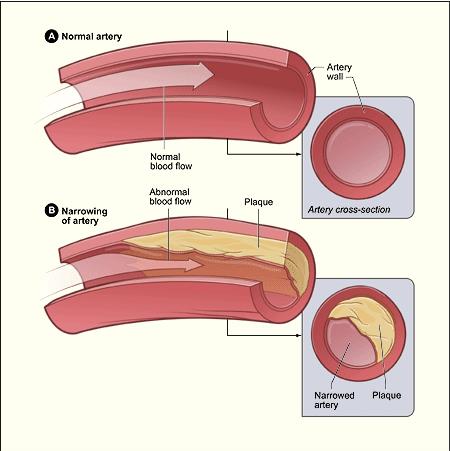
Atherosclerosis of arteries
Circulation Problems Testing and Exams
Angiograms are invasive vascular studies, they use a die and x-ray or MRI to assess the circulation of blockages (thrombi). They are done by inserting a catheter into the patient’s artery in the leg with the help of a needle,the catheter is moved to the arteries in question, the die is released into the vessel and live x-ray images show blockages or bottle necks in the vessels.
The Doppler ultrasound is a test used to diagnose both cerebrovascular disease and peripheral vascular disease. It utilizes high frequency sound waves that are being directed to the vein or artery which presents abnormalities and are then detected on the Doppler.
The magnetic resonance imaging technique is able to obtain 3D images of the body structure. The images are very clear and they are produced by using magnetic fields and recent computer technology. Due to the clarity of the pictures, the MRI can detect any signs of prior strokes. The MRI may also be performed on the heart if a cardiovascular disease is suspected. A lumbar puncture may also be performed but this is an invasive test which consists in taking a sample of cerebrospinal fluid from the space surrounding the spinal cord. The purpose of this test is finding traces of blood which may be due to cerebral hemorrhage.
Upon suspicion of foot circulation problems, the first-line study is the ankle brachial pressure index (ABPI/ABI) which is a measure of the fall in blood pressure in the arteries supplying the legs. A ABPI value that exceeds 0.9 is the confirmation that a peripheral vascular disease is not present. If the value of the ABPI is lower than 0.8 – 0,6 peripheral vascular disease exists but it is normally a mild case. On the other hand, a value below 0.5 confirms serious vascular condition.

